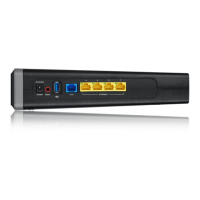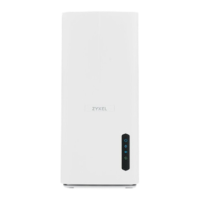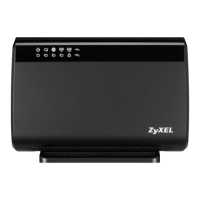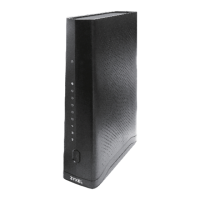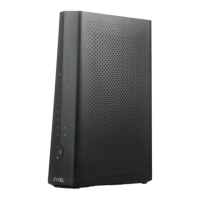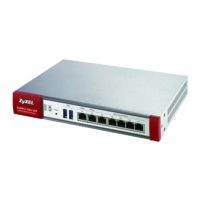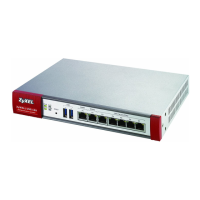Do you have a question about the ZyXEL Communications EX5501-B0 and is the answer not in the manual?
Explains how warnings and notes are displayed in the guide, highlighting potential hazards or important information.
Details text formatting and symbols used in the guide for clarity, such as bolding for screen names and angle brackets for clicks.
Lists and describes generic icons used in figures throughout the guide for visual representation.
Provides a general introduction to the Zyxel Device series and its capabilities.
Illustrates common use cases and network configurations for the Zyxel Device.
Outlines the various methods available for managing and configuring the Zyxel Device.
Offers recommendations for maintaining device security and effective management practices.
Describes the front and rear panels of various Zyxel Device models.
Details the function and behavior of the Zyxel Device's LED indicators.
Illustrates and describes the various ports and buttons available on the Zyxel Device.
Explains how to use the WPS button for quick and secure wireless connection setup.
Details how to reset the Zyxel Device to factory default settings to resolve issues.
Introduces the Web Configurator as an HTML-based interface for device setup and management.
Provides step-by-step instructions on how to access the Web Configurator.
Describes the main screen layout of the Web Configurator, including its key sections.
Explains how to use the Wizard screens for initial time zone and wireless network setup.
Guides the user through the initial setup process for time zone and wireless networks.
Details the steps for configuring the device's time zone during the initial setup.
Guides the user through configuring the Internet connection mode for the Zyxel Device.
Explains how to configure WiFi settings, including SSID and password, during initial setup.
Confirms the completion of the initial setup and the device's attempt to connect to the Internet.
Introduces the chapter's content on using various features of the Zyxel Device.
Provides instructions on how to set up a wired Internet connection.
Guides users on setting up a WiFi network for Internet access via the Zyxel Device.
Explains how to use USB devices for cellular backup, shared folders, and media server features.
Covers configuring firewall rules, parental controls, and MAC address filtering for network security.
Details how to configure VoIP services for making Internet calls.
Explains how to upgrade firmware, back up, and restore device configurations.
Introduces the MPro Mesh app for managing Zyxel devices and MPro Mesh networks.
Lists the key functionalities and tasks that can be performed using the MPro Mesh app.
Explains the MPro Mesh network capabilities, including AP and band steering.
Guides on changing the general WiFi SSID and key for improved security.
Provides steps to adjust extender locations for optimal WiFi signal strength.
Details how to set up an MPro Mesh Router with an MPro Mesh Extender.
Explains how to manage Zyxel devices and WiFi settings via the MPro Mesh app.
Describes the Connection Status screen for viewing Internet and wireless settings.
Explains how to view the network connection status of the Zyxel Device and its clients.
Provides basic system information about the Zyxel Device, including model and firmware.
Details how to enable or disable the main wireless network and configure SSIDs/passwords.
Guides on enabling or disabling guest WiFi networks for separate user access.
Explains how to view and manage parental control profiles and schedules.
Introduces the Zyxel Device's Broadband screens for configuring Internet access.
Lists tasks that can be performed using the Broadband screens for WAN configuration.
Explains key terms and concepts related to WAN IP addresses, ATM, PTM, and IPv6.
Details how to configure Internet access settings for DSL routers.
Explains how to configure Internet access settings for Ethernet, AON, and PON routers.
Guides on configuring cellular WAN connection as a backup for wired connections.
Explains settings for ADSL over PTM, Annex M, DSL PhyR, and SRA functions.
Introduces the Zyxel Device's Wireless screens for WiFi network and security setup.
Lists the tasks related to setting up WiFi connections using the Wireless screens.
Explains wireless basics, including radio communication and networking standards.
Guides on enabling Wireless LAN, setting SSID, and selecting security modes like WPA3-SAE.
Details configuring guest wireless networks and multiple BSSs on the Zyxel Device.
Explains how to allow or deny WiFi clients based on their MAC addresses.
Guides on configuring and using WiFi Protected Setup (WPS) for wireless connections.
Explains how to enable WiFi MultiMedia (WMM) for enhanced data transmission quality.
Details advanced wireless settings like RTS/CTS Threshold and DTIM Interval.
Describes how to scan for wireless LAN channel noises and view results.
Explains how to enable or disable MPro Mesh for Zyxel Mesh-supported devices.
Provides in-depth technical information regarding wireless LANs and their configurations.
Introduces the Local Area Network (LAN) and related configuration screens.
Lists tasks related to configuring LAN DHCP server and managing IP addresses.
Explains key terms like IP Address, Subnet Mask, DHCP, DNS, and RADVD.
Guides on setting the Local Area Network IP address, subnet mask, and DHCP settings.
Explains how to assign fixed IP addresses to individual computers based on MAC addresses.
Details how to configure Universal Plug and Play (UPnP) settings for network devices.
Guides on configuring IP alias and public static IP for partitioning physical networks.
Explains how to configure Vendor IDs for Set Top Boxes for automatic static DHCP entries.
Details how to remotely turn on a device on the network using Wake on LAN.
Explains how to identify a TFTP server for configuration file download via DHCP.
Provides technical background information on DHCP setup, DNS servers, and LAN TCP/IP.
Illustrates how to activate UPnP on the Zyxel Device and computer for network device discovery.
Explains how the Zyxel Device uses gateways and static routes for outbound traffic.
Guides on viewing and configuring static route rules for efficient traffic management.
Details how to view and configure DNS routes for forwarding DNS queries to specific WAN interfaces.
Explains how to override default routing behavior using policy-based routing.
Describes Routing Information Protocol (RIP) for exchanging routing information with other routers.
Defines Quality of Service (QoS) and its role in prioritizing traffic and managing bandwidth.
Guides on enabling QoS, setting upstream bandwidth, and assigning traffic priority.
Details how to configure QoS queue assignment for prioritizing traffic flows.
Explains how to add, edit, or delete QoS classifiers to group traffic.
Describes how to limit outgoing traffic transmission rate using the token bucket algorithm.
Guides on limiting incoming traffic rate and applying actions like drop or pass.
Explains the function of Network Address Translation (NAT) for IP address translation.
Lists tasks related to NAT configuration: Port Forwarding, Port Triggering, DMZ, ALG, Address Mapping, Sessions.
Defines Inside/Outside and Global/Local terms related to NAT and explains NAT functionality.
Guides on forwarding incoming service requests from the Internet to local network servers.
Explains how to configure trigger ports for dynamically allowing LAN computers to use services.
Details how to specify the IP address of a default server to receive packets not covered by Port Triggering.
Explains how Application Layer Gateway (ALG) supports address and port translation for specific applications.
Guides on mapping local IP addresses to global IP addresses for network access.
Explains how to limit concurrent NAT sessions per client for network stability.
Explains the Domain Name System (DNS) and its importance for accessing machines by name.
Guides on viewing and configuring manual DNS entries for domain name resolution.
Details how to update dynamic IP addresses to a hostname using a DDNS service provider.
Introduces IGMP/MLD protocols for managing multicast group memberships.
Explains how to configure IGMP/MLD group settings on the Zyxel Device.
Explains Virtual Local Area Networks (VLANs) for partitioning physical networks.
Guides on creating and managing VLAN groups for network segmentation.
Describes how interface groups allow communication within defined network segments.
Details how to create new user-defined interface groups or modify existing ones.
Introduces USB service features like file sharing and media server capabilities.
Guides on setting up file sharing through the Zyxel Device's LAN interfaces.
Explains how to enable the media server feature for playing media files from USB storage.
Explains the firewall's role in protecting the Zyxel Device and network from attacks.
Details how to use the firewall for protection against hackers and controlling network access.
Guides on setting the security level of the firewall based on packet traffic direction.
Explains how to configure customized services and port numbers for firewall rules.
Details how to create Access Control List (ACL) rules to accept, reject, or drop packets.
Explains how to activate protection against Denial of Service (DoS) attacks.
Provides technical background information on firewall rules and security considerations.
Introduces MAC filtering for permitting or denying client access based on MAC addresses.
Guides on enabling MAC Address Filter and adding host names and MAC addresses to the table.
Explains Zyxel Device's URL filtering for blocking access to inappropriate or harmful websites.
Details how to configure URL filtering settings to block user access to specific websites.
Explains parental control features for limiting Internet time and preventing access to inappropriate content.
Guides on enabling parental control and defining time periods for Internet access restrictions.
Details setting up parental control rules and URL filtering to block specific websites.
Introduces Scheduler Rules for defining time periods and days for Zyxel Device actions.
Guides on viewing, adding, or editing time schedule rules for features like Firewall Access Control.
Explains certificates for user authentication based on public-private key pairs.
Defines terms like Certification Authority (CA) and its role in issuing certificates.
Guides on viewing, generating requests for, and importing signed certificates.
Explains how to manage trusted Certification Authorities (CAs) for certificate validation.
Details the process of importing trusted CA certificates for validating Zyxel Device security.
Describes how to view detailed information about a certification authority's certificate.
Provides technical background information on certificates and their verification.
Introduces using VoIP technology for making phone calls over the Internet.
Lists prerequisites for configuring VoIP, including having a VoIP account and provider information.
Guides on setting up and configuring a SIP account for making and receiving VoIP calls.
Explains how to configure SIP server information and numbers for phone functions.
Details configuring SIP numbers and regions for IP phones connected to the Zyxel Device.
Guides on selecting the region to improve voice call quality based on physical location.
Explains how to add, edit, or remove speed-dial numbers for outgoing VoIP calls.
Describes how to view received, dialed, and missed calls in the call history list.
Explains how to determine event categories and display logs on the Zyxel Device.
Guides on viewing system logs, filtering by severity level and category.
Details viewing security-related logs and filtering by severity level and category.
Introduces viewing network traffic status and statistics for WAN/LAN interfaces and NAT.
Explains how to view WAN traffic statistics, including bytes received and sent.
Guides on viewing packet statistics for each LAN or WLAN interface.
Details how to view NAT status of Zyxel Device clients, including IP address and open sessions.
Allows viewing VoIP registration, current call status, and phone numbers.
Explains the Address Resolution Protocol (ARP) for mapping IP to MAC addresses on the LAN.
Guides on viewing IPv4-to-MAC and IPv6-to-MAC address mappings for connected devices.
Explains how routing is based on destination address and shortest path selection.
Shows IPv4 and IPv6 routing information, including destination, gateway, and subnet mask.
Introduces viewing multicast group status and traffic statistics using IGMP/MLD.
Explains how to view and configure IGMP multicast group settings.
Guides on viewing and configuring MLD multicast group settings for IPv6.
Provides an overview of viewing DSL statistics, including port details.
Details how to view DSL statistics, check port details, and see DSL counters.
Guides on viewing information and status of wireless clients associated with the Zyxel Device.
Introduces viewing cellular Internet connection status and backup functionality.
Details how to configure cellular settings, including connection status and signal strength.
Explains how to name the Zyxel Device (Host) and assign an associated domain name.
Guides on assigning a unique name and domain name for easy network recognition.
Introduces viewing settings and privileges of user accounts for device management.
Guides on creating or managing user accounts and their privileges on the Zyxel Device.
Explains remote management controls via interfaces and web services like HTTP, FTP, Telnet.
Guides on configuring interfaces and specifying service port numbers for remote access.
Details viewing public IP addresses allowed to access local management services.
Explains how to add public IP addresses or domain names for management access.
Explains how to configure SNMP settings for network device management and monitoring.
Guides on configuring SNMP agent, community strings, system name, and location.
Introduces configuring system date, time, and time zone for accurate scheduling and logging.
Details how to configure the Zyxel Device's time, time zone, and Daylight Savings settings.
Explains how to send reports, logs, or notifications via email using a mail server.
Guides on viewing, removing, and adding email account information for log notifications.
Describes configuring where Zyxel Device sends logs and the types of logs recorded.
Details configuring log storage (remote syslog or local file) and log types.
Explains how to upload new firmware to enhance Zyxel Device performance.
Guides on uploading firmware via Zyxel website or online check for device performance.
Provides information on factory default settings and backup configuration.
Details how to back up and restore device configuration files.
Explains how to remotely reboot the Zyxel Device without turning off the power.
Introduces the Diagnostic screen for identifying device problems.
Explains terms and concepts related to CFM, OAM, and connectivity fault discovery.
Guides on using ping, traceroute, nslookup, or speed test for troubleshooting connectivity.
Details how to configure and perform Connectivity Fault Management (CFM) actions.
Explains Link Layer Ethernet OAM for transmitting link status information.
Guides on performing OAM F4 or F5 loopback tests to verify connectivity.
Provides suggestions to solve common problems encountered with the Zyxel Device.
Addresses issues related to the Zyxel Device not turning on or LEDs behaving unexpectedly.
Offers solutions for not knowing the IP address or forgetting the admin password.
Troubleshoots issues related to not accessing the Internet or slow/intermittent connections.
Provides solutions for slow or intermittent WiFi connection issues.
Addresses issues where the Zyxel Device fails to detect a connected USB device.
Troubleshoots issues where a computer cannot detect UPnP settings from the Zyxel Device.
Lists the essential product information needed when contacting customer support.
Provides contact details for Zyxel's global headquarters and regional offices.
Discusses ad-hoc and infrastructure wireless LAN topologies.
Explains how to configure an independent wireless LAN connecting computers directly.
Defines a Basic Service Set (BSS) as communications through a single access point (AP).
Defines an Extended Service Set (ESS) as overlapping BSSs connected by a wired network.
Explains radio frequency channels used by wireless devices and how to avoid interference.
Details the RTS/CTS mechanism designed to prevent collisions due to hidden nodes.
Explains the maximum data fragment size before fragmentation into smaller data frames.
Discusses compatibility with IEEE 802.11b and data rates/modulation for 802.11g.
Explains wireless security methods like data encryption, authentication, and MAC address filtering.
Details IEEE 802.1x standard for extended authentication and accounting features.
Explains RADIUS client-server model for authentication, authorization, and accounting.
Describes RADIUS messages exchanged for user authentication and accounting.
Discusses popular EAP authentication types like EAP-MD5, EAP-TLS, EAP-TTLS, PEAP, LEAP.
Introduces IPv6 as an enhancement to IP address size and features.
Explains the 128-bit IPv6 address format and its abbreviation methods.
Defines IPv6 prefix length for representing network addresses and subnet masks.
Explains the link-local address format for uniquely identifying devices on a local network.
Defines a global address as a unique identifier for devices on the Internet, similar to public IPv4.
Describes the unspecified IPv6 address used when a device lacks its own address.
Explains the loopback address for sending packets to a device itself.
Describes IPv6 multicast addresses for sending packets to groups of hosts.
Explains the role of DHCP relay agents in forwarding messages between servers and clients.
Details how an IPv6 router uses a prefix to generate LAN IP addresses for hosts.
Explains the Internet Control Message Protocol for IPv6 (ICMPv6) for error reporting.
Describes NDP for discovering IPv6 devices and tracking neighbor reachability.
Provides a short, descriptive name for a network service.
Specifies the type of IP protocol used by the service, such as TCP/UDP or USER-DEFINED.
Indicates the IP port number or IP protocol number associated with a service.
Offers a brief explanation of applications or situations where a service is used.
States the copyright ownership and usage restrictions for the publication.
Disclaims Zyxel's liability for product application or use and patent rights.
Provides regulatory compliance information for the USA and European Union areas.
Contains FCC EMC and Radiation Exposure statements applicable to products used in the USA.
Includes Declaration of Conformity for EU Directive 2014/53/EU and UK Regulation.
Declares compliance with EU Directive 2014/53/EU and UK regulation for wireless products.
| Brand | ZyXEL Communications |
|---|---|
| Model | EX5501-B0 |
| Category | Gateway |
| Language | English |

